 |
 |
 |
| |
Clinicians May Overlook CD4 Percent in HIV+ When Deciding on PCP Prophylaxis
|
| |
| |
IDWeek, October 2-6, 2013, San Francisco
Mark Mascolini
Although US guidelines recommend considering prophylaxis for Pneumocystis jiroveci pneumonia (PCP) when HIV-positive people have a CD4 percent below 14%, clinicians at a New York City hospital appeared to overlook that advice in people who also a CD4 count above 200 [1].
Because of late diagnosis and poor antiretroviral adherence, PCP remains a threat to people with HIV infection. A recent 1259-person study in France found that almost half of HIV-positive people with newly diagnosed PCP had already entered HIV care, and three quarters of that group had started antiretroviral therapy [2].
US guidelines call for PCP prophylaxis in anyone with a CD4 count below 200 or oropharyngeal candidiasis. People with a CD4 percent below 14% should be considered for prophylaxis, but CD4 counts and percent are discordant at these cutoffs in 16% to 25% of people. It remains unclear how often people with a count below 200 and a percent above 14%, or vice versa, get PCP prophylaxis and how these decisions affect clinical outcomes.
To address these issues, researchers at New York's Harlem Hospital retrospectively reviewed electronic medical records of 429 HIV-positive people with a CD4 count and percent measured from July 2010 to April 2011. They classified CD4 results as discordant in two ways:
Discordance A (Dis-A) meant a person had a CD4 count above 200 and a CD4 percent below 14%.
Discordance B (Dis-B) meant a person had a CD4 count below 200 and a CD4 percent above 14%.
The Harlem Hospital team determined whether people were on PCP prophylaxis in the 6 months before and after their CD4 measurements. Prophylaxis could be trimethoprim-sulfamethoxazole, atovaquone, dapsone, or pentamidine.
Just over half of study participants (53%) were men, 81% were non-Hispanic black, 15% Hispanic, and 2% white. Fifty-seven people (13%) had CD4 discordance, including 28 with Dis-A and 29 with Dis-B. Twenty of the 28 people with Dis-A (71%) were not prescribed PCP prophylaxis, whereas 4 of 29 people with Dis-B (14%) were not prescribed prophylaxis. People with Dis-A were almost 95% less likely to be prescribed prophylaxis (odds ratio 0.064, 95% confidence interval 0.0168 to 0.2436, P < 0.0001).
Seventeen people in the Dis-A group (61%) and 16 in the Dis-B group (55%) were taking antiretroviral therapy. One person in the Dis-A group, who was taking antiretrovirals but not PCP prophylaxis, was admitted to the hospital with presumed PCP and responded to intravenous Bactrim. This person had a CD4 count of 680 but a CD4 percent of 6%. No one in the Dis-B group had PCP during the study period. Four of 28 people in the Dis-A group went to the hospital for respiratory illness, compared with 10 of 29 in the Dis-B group (14% versus 34%).
The researchers observed that CD4 count and CD4 percent cannot be considered equivalent. CD4 count is a product of CD4 percent derived from flow cytometry and complete white cell count and lymphocyte differential. But CD4 percent is a less variable measure because CD4 count can be affected by infections, smoking, alcohol, chemotherapy, steroids, and diurnal changes.
In this population, the Harlem Hospital team concluded, clinicians were more likely to prescribe PCP prophylaxis based on absolute CD4 count rather than CD4 percent when faced with discordant CD4 results. The case of PCP in a person with an essentially normal CD4 count but low CD4 percent indicates that this approach could leave some patients vulnerable to PCP.
References
1. Anyimadu H, Doshi B, Sivapalan V, Mannheimer S, Hirsch-Moverman Y. Absolute CD4 count and percentage discordance impacting Pneumocystis jirovecii pneumonia (PJP) prophylaxis in HIV-infected patients. IDWeek 2013. October 2-6, 2013. San Francisco. Abstract 1501.
2. Denis B, Guiguet M, Gregoire G, et al. Pneumocystis jirovecii pneumonia (PCP) in HIV infected patients in France in the combined antiretroviral therapy (cART) era is associated with late presentation or poor adherence. 53rd ICAAC. September 10-13, 2013. Denver. Abstract H-1260. http://www.natap.org/2013/ICAAC/ICAAC_79.htm
-----------------------
Reported by Jules Levin
ABSOLUTE CD4 COUNT AND PERCETAGE DISCORDANCE IMPACTING PNEUMOCYSTIC JIROVECII PNEUMONIA (PJP) PROPHYLAXIS IN HIV-INFECTED PATIENTS
Henry Anyimadu, MD. FACP. CWSP.; Bijal Doshi, MD.; Yael Hirsch-Moverman, PhD.; Vel Sivapalan, MD. FACP.; Sharon Mannheimer, MD
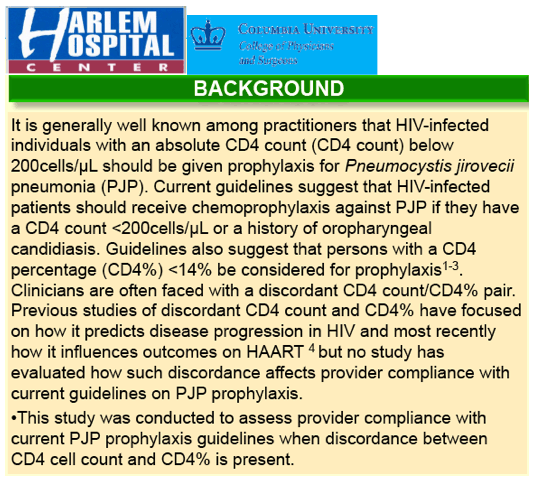
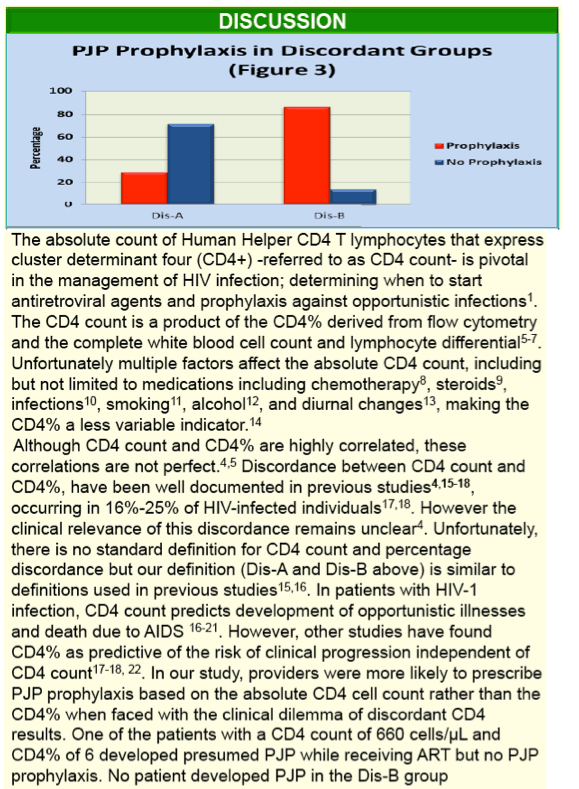
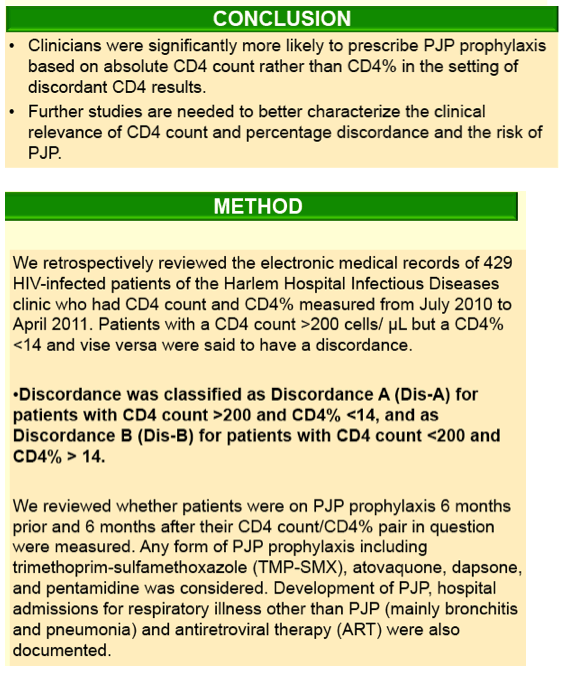
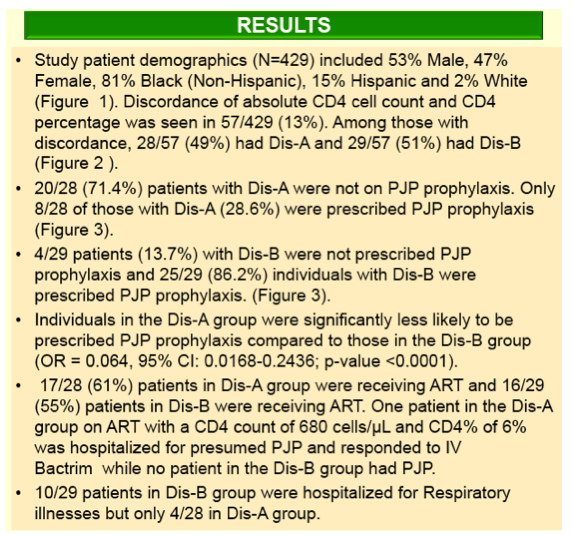
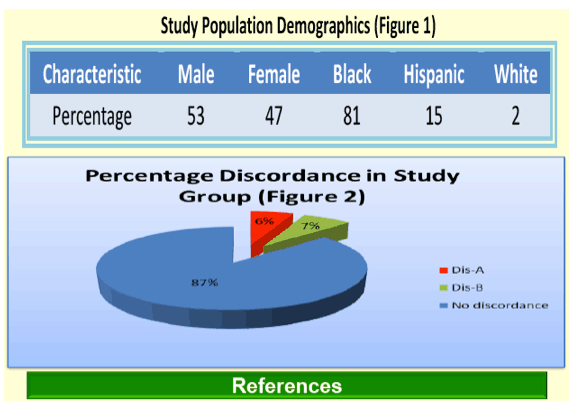
Corresponding author email: henr51@yahoo.com
Program Abstract
Background:
Current guidelines suggest that HIV-infected patients should receive chemoprophylaxis against PJP if they have a CD4 count less than 200cells/μL or oropharyngeal candidiasis. Guidelines also recommend that persons with a CD4 percentage (CD4%) below 14% should be considered for prophylaxis. Discordance between CD4 count and CD4% occur in 16%-25% of HIV-infected patients. This study was conducted to assess provider compliance with current PJP prophylaxis guidelines when such discordance is present.
Methods:
Electronic medical records of HIV-infected patients who had CD4 count and CD4% measured at our clinic from July 2010 to April 2011 were reviewed. Patients with CD4 count >200, but CD4% <14 were defined as Discordance A (Dis-A) and conversely CD4 count < 200 but CD4% > 14 defined as Discordance B (Dis-B). We assessed whether these patients were on any form of PJP prophylaxis, developed PJP, received antiretroviral therapy, or had any hospital admissions for respiratory illnesses other than PJP. Odds ratios were calculated and Fisher's exact test was used to assess associations for categorical variables.
Results:
A total of 429 HIV-infected individuals had CD4 cell count and CD4% measured during the study period. Median age was 46 (Range 18-87 years), 53.0% Male, 81.0% non-Hispanic Black, 15.0% Hispanic and 2.0% White. CD4 count and percentage discordance was seen in 57/429 (13%). 28/429 had Dis-A and 29/429 had Dis-B. Dis-A participants were significantly less likely than Dis-B participants to be prescribed PJP prophylaxis (29% vs. 86%; OR = 0.064, 95% CI: 0.0168-0.2436; p-value <0.0001). One patient in the Dis-A group who was receiving ART with CD4 count of 680 cells/μL and CD4% of 6%, had presumed PJP.
Conclusion:
In this study, the use of PJP prophylaxis seemed to be determined more by the CD4 cell count than the CD4 percent. Although our study is based on a retrospective medical record review, it forms a platform for further studies to better understand the clinical relevance of CD4 count and percentage in determining PJP prophylaxis.
|
| |
|
 |
 |
|
|